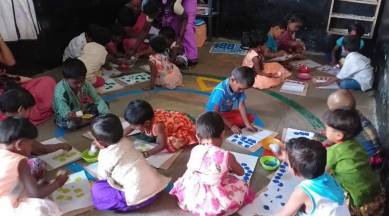Stay updated with the latest - Click here to follow us on Instagram
‘Poshan Bhi, Padhai Bhi’: Centre to push Early Childhood Care and Education through Anganwadis
Anganwadi centres will be reimagined and recalibrated to focus not only on nutritional aspect of children and mothers but also on early learning of children

The Centre is planning to push ‘Early Childhood Care and Education’ through 14 lakh anganwadi centres this year under the ‘Poshan Bhi, Padhai Bhi’ slogan as per the announcement made by Women and Child Development Minister Smriti Irani in September last year.
For this, anganwadi centres will be reimagined and recalibrated to focus not only on the nutritional aspect of children and mothers but also on early learning of children under 6 years, particularly those under 3 years, which has proven to be a foundation for a child’s development.
monthly limit of free stories.
with an Express account.
While early learning has always been a part of the government’s Integrated Child Development Scheme (ICDS), it has largely been neglected as it has, so far, been seen as secondary to nutrition.
The government now plans to reposition anganwadis as pre-schools as well, providing early learning access, particularly to children from socially and educationally backward communities.
The WCD Ministry had set up a 22-member high level task force, chaired by former IAS officer Sanjay Kaul, to look into the matter. The task force submitted its report to the ministry in August last year, and a number of its recommendations are now being considered for implementation by the government.
The government’s plans for Early Childhood Care and Education (ECCE) are in keeping with the National Education Policy 2020 which has prioritised “foundational literacy and numeracy” and has said that the major portion of a child’s brain development occurs before the age of 6 years, while noting that a quality ECCE is not available to crores of children.
The task force has said that it is cognisant of two emerging trends — the perceptible shift of young children into private pre-schools and under-age children being admitted in Class 1 in a few states. It has said that the quality of services provided at Anganwadi centres is often perceived as being inferior to private nursery schools, resulting in the shift.
“This has not only put a burden on parents but also resulted in the mushrooming of a large number of poor quality private preschools,” it has said.
The task force has, therefore, recommended a “mission-mode approach” to “rebranding of anganwadis” with upgraded infrastructure, ECCE materials, play equipment, etc. It also recommended involvement of panchayat raj institutions, women’s self-help groups, local non-government organisations, and college volunteers to brighten up the look and feel of the Anganwadi as an early learning environment.
The task force has also recommended the “re-designation” of anganwadi workers as anganwadi teachers, and helpers as childcare
workers; infrastructure improvements; reversing the declining participation of children through measures such as adding quality
nutrition supplements such as eggs and milk, leveraging MGNREGS funds; expansion of timings; setting up of creches and day care services; as well as additional workers.
The Centre, however, indicated that increasing the number of workers in the system may not be feasible at this point due to budgetary concerns.
The report also takes into account the nutrition component as being vital for cognitive development.
“The taskforce notes that over 35% of young children in India are stunted, according to the latest NFHS data. Admittedly, this is a reduction from previous years. While one in every two young children was stunted in 2005-06, the prevalence is now one in three, in 2019-21. Nevertheless, in absolute numbers, India continues to have the largest population of stunted children in the world. Child stunting impacts later developmental outcomes for children, including their ability to learn at school,” it has said.
Noting that NFHS-5 also found that only 11.3% of children below 2 years received an adequate diet, the task force recommended the introduction of eggs as an “effective intervention”.
The task force has also recommended the introduction of creche facilities for children under 3 years as another intervention.
It has recommended that five per cent of the total number of Anganwadis in the country should be upgraded as Anganwadi-cum-crèches, that is around 70,000 Anganwadi-cum-crèches in the first phase.
It has further recommended that government programmes such as Mahatma Gandhi National Rural Employment Guarantee Scheme (MGNREGS) and National Rural Livelihood Mission (NRLM) can be leveraged in upgrading the anganwadi system.
It has said that the Centre needs to develop a common curriculum across different models and that there should be
an emphasis on education in the child’s mother tongue.
To enhance the Early Learning programme, the task force has said that an estimated total annual outlay of Rs 9,800 crore is required.
Till March 2022, a total number of 285.82 lakh children of 3-6 years were covered under the early childhood education of which 146.04 lakhs were boys and 139.78 lakhs girls.